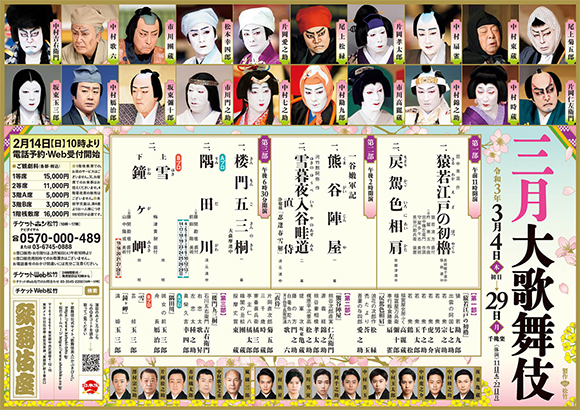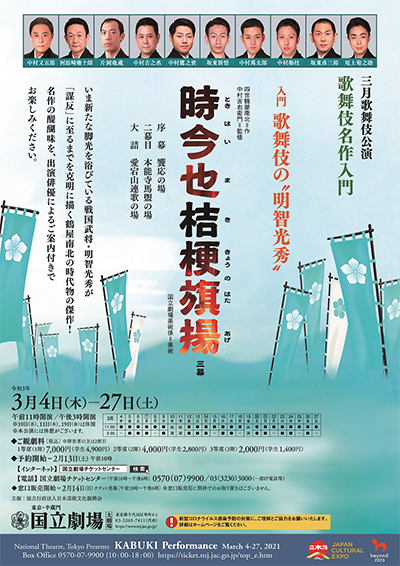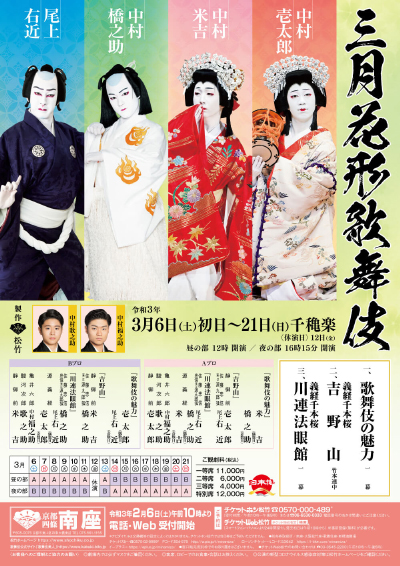| MARCH 2021 |
|
5 shows in T˘ky˘ (Kabukiza, National Theatre), 2 in Ky˘to (Minamiza), 1 in Yamaga (Yachiyoza) and 2 tours (Shungy˘ Special Tour, Classics Tour)!
|
| Kabukiza (T˘ky˘) |  |
| Dates | 4 ~ 29 March 2021 Sangatsu ďkabuki March Grand Kabuki |
| 1st program |
Saruwaka Edo no Hatsuyagura |
| 2nd program | |
| 3rd program A | |
| 3rd program B |
Yuki Kane-ga-Misaki |
| Casting |
Living National Treasure Onoe Kikugor˘, Living National Treasure Nakamura Kichiemon, Living National Treasure Band˘ Tamasabur˘, Living National Treasure Kataoka Nizaemon, Living National Treasure Nakamura T˘z˘, Nakamura Tokiz˘, Nakamura Senjaku, Nakamura Kinnosuke, Kataoka Ainosuke, Matsumoto K˘shir˘, Nakamura Kankur˘, Nakamura Shichinosuke, Kataoka Takatar˘, Onoe Sh˘roku, Ichikawa Danz˘, Band˘ Yajűr˘, Nakamura Karoku, Ichikawa Komaz˘, Band˘ Kamez˘, Nakamura Kash˘, Nakamura Tanenosuke, Nakamura Kangyoku |
| Comments |
The March Grand Kabuki at the Kabukiza. The A program is staged the 4th, 5th, 6th, 7th, 8th, 9th, 10th, 12th, 13th, 14th, 17th, 18th, 19th, 23rd, 24th, 25th, 26th and 29th of March 2021. The B program is staged the 15th, 16th, 20th, 21st, 27th and 28th of March 2021. There is no performance the 11th and the 22nd of March 2021.
|
 |
| National Theatre (T˘ky˘) |
| Dates | 4 ~ 27 March 2021 |
| Program | |
| Casting |
Onoe Kikunosuke, Band˘ Hikosabur˘, Nakamura Baishi, Nakamura Matagor˘, Kataoka Kamez˘, Kawarasaki Gonjűr˘, Nakamura Mantar˘, Band˘ Shingo, Nakamura Takanosuke, Nakamura Kichinoj˘ |
| Comments |
This month, the program at the National Theatre is called Kabuki Meisaku Nyűmon (literally 'Introduction to Kabuki Masterpieces'). The drama "Badarai no Mitsuhide" is staged with Onoe Kikunosuke in the role of Takechi Mitsuhide. There is no performance the 10th, the 11th and the 19th of March 2021. |
 |
|
|||
| Dates | 6 ~ 21 March 2021 Sangatsu Hanagata Kabuki March Young Actors Kabuki |
||
| Program A |
Kabuki no Miryoku
|
||
| Program B |
Kabuki no Miryoku
|
||
| Casting |
Nakamura Kazutar˘, Onoe Ukon, Nakamura Hashinosuke, Nakamura Yonekichi, Nakamura Fukunosuke, Nakamura Utanosuke |
||
| Comments |
A special Young Actors Kabuki program in Ky˘to at the Minamiza.
|
||
 |
| Shungy˘ Special Tour | |
| Dates | 30 March ~ 4 April 2021 Shungy˘ Tokubetsu K˘en The Dawn of Spring Special Performances |
| Program |
T˘ku K˘nÔ |
| Casting |
Nakamura Kankur˘, Nakamura Shichinosuke, Nakamura Tsurumatsu, Nakamura Kantar˘, Nakamura Ch˘zabur˘, Nakamura Kosabur˘, Nakamura Ich˘, Sawamura Kunihisa |
| Comments |
The 2nd edition of the Spring Tour of the Nakamuraya guild with performances in 4 cities (5 venues). The second item (T˘ku K˘nÔ) in this program is a talk on stage (literally 'Talk Corner'). In March, the troupe performs in Kariya at the Kariya Cultural Center Iris the 30th of March and in Higashi-Hiroshima at the Higashi Hiroshima Arts & Culture Hall Kurara the 31st of March.
|
| Classics Tour | |
| Dates | 5 ~ 24 March 2021 Koten he no Izanai Invitation to the Classics |
| Program |
Benten Musume Meo no Shiranami
|
| Casting |
Ichikawa Ebiz˘, Ichikawa Udanji, Nakamura Kotar˘, Kataoka Ichiz˘, Ichikawa Omez˘, Ichikawa Kudanji, ďtani Hiromatsu |
| Comments |
A special tour in 14 cities for the heir of the Naritaya guild.
|
|
|||
| Dates | 26 ~ 29 March 2021 Ichikawa Ebiz˘ Yachiyoza Tokubetsu K˘en Ichikawa Ebiz˘ Yachiyoza Special Performances |
||
| Program |
Shibai-mae Mimasu no Nigiwai Benten Musume Meo no Shiranami
|
||
| Casting |
Ichikawa Ebiz˘, Ichikawa Udanji, Nakamura Kotar˘, Kataoka Ichiz˘, Ichikawa Omez˘, Ichikawa Kudanji, ďtani Hiromatsu, Horikoshi Kangen, Ichikawa Botan |
||
| Comments |
A special program starring Ichikawa Ebiz˘ in Yamaga at the Yachiyoza, a traditional wooden-built theater.
|
||
|
|
| Contact | Main | Top | Updates | Actors | Plays | Playwrights | Programs | Links | FAQ | Glossary | Chronology | Illustrations | Prints | Characters | Derivatives | Theaters | Coming soon | News |